Cut and Come Again Lettuce Alabama
en Español
El inglés es el idioma de control de esta página. En la medida en que haya algún conflicto entre la traducción al inglés y la traducción, el inglés prevalece.
Al hacer clic en el enlace de traducción se activa un servicio de traducción gratuito para convertir la página al español. Al igual que con cualquier traducción por Internet, la conversión no es sensible al contexto y puede que no traduzca el texto en su significado original. NC Country Extension no garantiza la exactitud del texto traducido. Por favor, tenga en cuenta que algunas aplicaciones y/o servicios pueden no funcionar como se espera cuando se traducen.
English is the decision-making linguistic communication of this folio. To the extent there is any conflict betwixt the English language text and the translation, English controls.
Clicking on the translation link activates a gratuitous translation service to convert the folio to Spanish. As with any Cyberspace translation, the conversion is not context-sensitive and may non translate the text to its original significant. NC State Extension does not guarantee the accuracy of the translated text. Please note that some applications and/or services may non function as expected when translated.
Collapse ▲
Hardly a day goes by without mention of the obesity crisis in our state which at present costs united states an estimated 1.4 trillion dollars a year. My wife and I struggle with weight just like everyone else. On a recent trip I gained 5 lbs in less than 4 days! I was able to lose those 5 lbs once I got dwelling and returned to one of the life-changing habits that we have developed from our home nutrient production system. We eat a salad everyday from our garden (except for vacations). We too consume a lot of greens in our breakfast smoothies and soups, stir chips, omelettes, and casseroles.
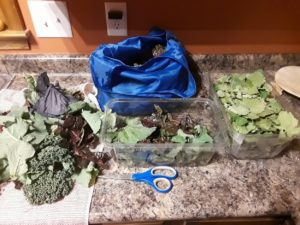
Fresh cut greens from cabbage, turnips, kale, Swiss chard, rutabaga, and loose leafage lettuce
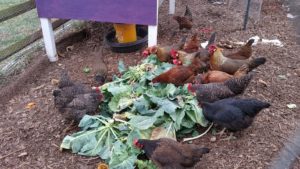
Surplus greens tin can be converted into eggs
Either I transplant seedlings purchased or I broadcast seed from catalogs (various pick of varieties only more expensive) or local garden supply stores (traditional varieties only very affordable). Broadcasting seed is the easiest and results in a dumbo bed of baby greens. Depending on irrigation and predicted weather, I will concentrate the broadcast seeds where they will get regular moisture (that may mean forth a drip irrigation line). As you cut the larger leaves, new plants are underneath and ready to emerge. Dumbo plantings result in lots of undersized plants which are great for a baby leaf cut-and-come up-again salad but non good if you want a full size head of romaine lettuce for a Caesar salad. Make sure that swath cutting of greens is merely getting edible greens. Don't accidentally cutting parsnip greens for case, that would make for a toxic salad! For full size heads of leafy greens you will need to give them enough infinite – 6 to 12 inches in the row and 12 inches between rows.
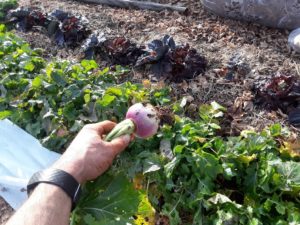
Turnips tin provide you lot with a steady supply of greens and a delicious root.
If you lot purchase a big diversity of seeds it is worth storing them correctly to get multiple seasons out of them. Put them in the refrigerator in a seal-able glass jar when they arrive. After you lot have planted for the season, store them in the freezer. Keep them dry and cold and germination rates will be good for several years in well-nigh cases.
The following is our annual plan to keep leafy greens coming in all twelvemonth circular.
Spring and Autumn Planting
In early to mid-March and again in belatedly August to early September found a diverseness of leafy greens. The cool flavour of spring (March – May) and autumn (Sept – Nov) are the easiest times to abound nigh salad fare plants.
Loose leaf lettuce – I always cull a carmine variety to add color to the salad. I program on adding an oakleaf varieties for salad texture in the hereafter. This year nosotros are transplanting variety Cherry-red Sails and I volition space those transplants six inches in the row and 12 inches between.
Spinach – varieties Bloomdale and Carmel are varieties that I transplant in the leap and autumn respectfully. Tyee and Hybrid seven are varieties that we may broadcast to give united states foliage texture and color multifariousness.
Swiss chard – Bright Lights are a favorite. For cold tolerance choose non colored stem varieties like Argentata.
Kale – Winterbor types are very cold tolerant. Ruby Russian is one of the sweetest varieties that we plant.
Beets – a homestead favorite because the greens are delicious and you also become a root that we like to pickle (for salad eating or using equally a side dish) or boil and freeze (added to a breakfast smoothie they requite a neon color). I constitute Balderdash's Blood beets in the spring because I love the deep cherry-red leaves. We cull Cylindra beets in the fall because they are very cold tolerant. I like to circulate these seeds (mostly for the baby greens) and establish transplants (for the greens and roots).
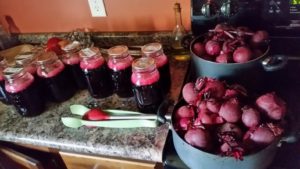
Nosotros use beet greens, roots, and we save the beet juice left later on boiling. That juice is excellent in smoothies.
Turnips – another homestead favorite; delicious greens and a surprisingly tasty root.
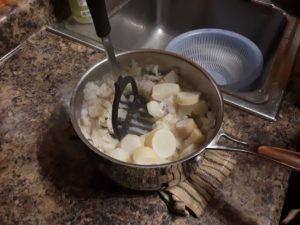
Mashed turnips are merely equally succulent as mashed potatoes, especially with a petty cheese and salt
We slice and roast turnips for a side dish or use them every bit a mashed potato substitute. Diversity Purple Top is common and succulent.
Parsnips
Cabbage – a red variety like Red Perfection is typically what we become with.
Summer Planting
Heat tolerant greens are a little trickier and the ability to take a fresh salad from your garden in July and August is the sign of a skilled (or lucky) gardener. We plan on planting estrus tolerant greens multiple times in early on May, late May, mid-June, and early on July. This successional planting schedule will provide some insurance if i of the crops fails, gets eaten, or runs out of steam.
Mustard Greens – varieties like Gilded Frill and Green Wave can practice very well in the estrus if you like that mustardy spice in your salad.
Asian Greens – Purple Lady Bok Choy brings a lovely purple color to salads. Nosotros broadcast this.
Batavian Lettuces – variety Muir is i of the most oestrus tolerant varieties. Green Star, Coastal Star, New Red Fire, and Ruby-red Oak leaf are also great.
Vegetable Amaranth – in that location are both cherry-red and purple leaf varieties. These are cousins of pigweed then nosotros know they love the rut!
Malabar Spinach – this is a tropical vine, not a truthful spinach diverseness. The leaves are a little succulent but tasty. Exist careful, this plant will driblet a lot of seed and it needs a trellis.
Sweet white potato leaves – we plant Bearegard and Bayou Belle sweet potatoes. These leaves are succulent, simply don't over-harvest from ane vine or you might reduce root yields.
Squash shoots – squash varieties that form a vine (nearly wintertime squash varieties) will produce excess biomass from multiple vines. You tin pinch off the tips of these vines along with i or ii under-developed leaves. These greens are prized in other cultures and are very tender and delicious in stir fries.
Wintertime Planting
The cold multifariousness greens should be started in mid to belatedly Sept along with your regular absurd season fall greens. Sometimes I exercise another planting in late Sept but I have found formation and growth to exist poor if I look until mid Oct (depends on the temperatures). I highly recommend yous take a wait at Pam Dawling'due south data on what varieties endured the cold best. Pam is a market gardener guru and has written many excellent books are market gardening and food production. Pam lives in Virginia in a zone 7a, and then her multifariousness selections will work very well for much of North Carolina.
Kale – diversity Vates survived -8 degrees F (outside and uncovered). Winterbor and Dwarf Siberian will likewise survive single digits.
Beets – Cylindra is one of the most common cold tolerant and survived 12 degrees F.
Lettuce – some of the hardiest varieties include Buckley, Light-green Forest, and Tango.
Turnips – variety Regal Superlative survives 12 degrees F.
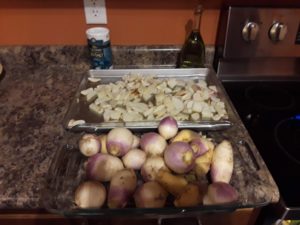
Roasted turnip slices are a swell snack to pack in lunches. Nosotros mix them with sweetness spud slices too.
- Catawba Canton Gardening Abode Page
- Annual Garden Calendar for Catawba County
- Projection Homestead – Grow Your Ain Nutrient on Less than 1 Acre in Catawba County
- Homesteading – Eat a Salad From Your Garden Everyday
- Homesteading: Abound Your Own Food – Planting Schedule
- Homesteading – Manage Weeds While Building Soils
- Homesteading – Choosing the Right Varieties
burnsworgetwoncer.blogspot.com
Source: https://catawba.ces.ncsu.edu/homesteading-grow-your-own-food-on-less-than-1-acre/homesteading-eat-a-salad-from-your-garden-everyday/
ارسال یک نظر for "Cut and Come Again Lettuce Alabama"